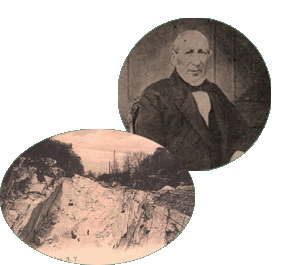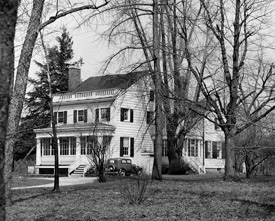Alexander Masterton (1797-1859)
New York Quarry Owner and Builder
One of the Masterton emigrants to the United States who became very wealthy was Alexander Masterton, a stone cutter who became a quarry owner and supplied white marble for many neo-classical buildings in the easternmost United States. His company, Morgan's Marble Westchester, donated one of the 193 memorial stones adorning the east and west interior walls of the Washington Monument. His family became prominent citizens of Bronxville and Eastchester, suburbs of New York City between Yonkers, Mount Vernon and New Rochelle.
Genealogy
The clue to Alexander Masterton's orgins lies in his entry in the Directory of Scottish Settlers in North America 1625-1825 (reproduced below). The Old Parish Records contain only one Alexander Masterton born in Forfar in 1797 - the firstborn son of James Masterton and Agnes Millar who had been married in Forfar on 28th November 1795. It is likely that this James was christened on 20th April 1769, the son of Alexander Masterton and Elizabeth Watson (married in Forfar on 26th September 1761). The firstborn daughter of James Masterton and Agnes Millar was named Elizabeth and so the siblings' names are consistent with the Scottish Naming Pattern for these parents. Children of James Masterton and Agnes Millar as recorded in the OPR are:
- Alexander Masterton (chr 10 January 1797)
- William Masterton (chr 7 June 1799)
- Elizabeth Masterton (chr 15 December 1802)
A fuller genealogy of Alexander Masterton senior's extended family can be found by clicking on his name.
Alexander Masterton married Euphenius Morrison (c1799-1860) of Eastchester and had seven children:
- William James Masterton
- Alexander Masterton Jr (c1822 - 4 May 1899)
- Robert Morgan Masterton (c1824 - )
- Joseph Tucker Masterton (c1827 - bef May 1862)
- Mary M. Masterton (c1830)
- John M. Masterton (c1836 - )
- George Masterton (1844- )
Alexander Masterton Jr achieved notoriety in death, ending his life within a few hours of being shot five times by James Neale Plumb in the Burlington Hotel on West Thirtieth Street, New York. Plumb claimed to have been financially ruined by Masterton and that Masterton had attempted to alienate the affections of his wife and children and to cause his social downfall. Plumb died a month later at Bellevue Hospital of exhaustion, induced by facial erysipelas [a strep infection].
John M. Masterton achieved notoriety in life, when his bank, J. M. Masterton Co. of Mount Vernon, failed and Masterton was convicted of larceny for having received money from depositors when he and his partner, Philip Lucas Jr., knew that the bank was insolvent.
ALEXANDER MASTERTON
Born Forfar 1797. To Halifax c.1814. Settled in N.Y. c.1818. Married Euphemia Morrison. Died 16 January 1859.
Directory of Scottish Settlers in North America 1625-1825
David Dobson
Baltimore Genealogical Publishing Co. Inc.
1984
Boston News-Letter and City Record
Vol II. July 1826-January 1827.
12 August, 1826, Boston
The Boston Style of Building is adopted in New-York, as will be seen by the following article.
Great Arrival. - We announce, with much pleasure, the arrival of the sloop Miller's Daughter, Capt. Davis, with the first of the Grecian Ionic Pillars, from the Eastchester quarry, intended for the front of the Merchants' Exchange, in Wall-St. This pillar weighs 25 tons, is 27 1/2 feet long, and 3 feet 6 inches diameter at the base. The other three are of similar size, and it is calculated that they will be delivered here in three weeks. The contractors, Messrs Francis Kain, Alexander Masterton, and Robert Smith, have, in this stupendous work, encountered almost insurmountable difficulties, and were advised, by the most skilful architects and others, to abandon their undertaking; but their minds were bent on producing a work never before attempted in this country, and they have, to their distinguished credit, succeeded. When these columns are raised, they will excite the admiration of every man of science, and prove a lasting monument to the memory of the enterprizing mechanics who had the boldness to undertake the Herculean work. The above quarry is five miles from the landing place where the Miller's Daughter took in this column, and only eight days were occupied in taking it to the place of shipment. - N.Y. Gazette.
The Boston News-Letter and City Record
Jerome V.C. Smith, M.D. (ed)
Vol II. July 1826-January 1827, p. 620
Abel Bowen
Boston, 1826


EARLY 19TH CENTURY FAMILIES
It was almost a century after the arrival of the Underhills and Morgans before the next modest influx of settlers would make their mark. Alexander Masterton (photograph top left), a prosperous stonecutter from Scotland, was lured by quarries of fine white marble that were discovered in nearby Tuckahoe in 1822 (photograph top left). Masterton eventually supplied stone for Greek Revival buildings from Boston to New Orleans, including Washington D.C. capitol buildings destroyed during the War of 1812. In 1835 Masterton built a neo-classical wooden home called Ridgecroft (photograph top right) for his wife and six children. The house is now listed on the National Register of Historic Places. It remained in the family until the 1959 death of Masterton's granddaughter Amie Dusenberry, who like many of her Masterton and Dusenberry ancestors, was a vital force in Village life.
MASTERTON, ALEXANDER
A native of Scotland, who was formerly working as a journeyman mason, but, with the national energy of his countrymen, he soon became a prominent builder and architect. By his reputation he obtained a contract for building the Custom House and other public buildings, and is now possessed of considerable property. $200,000.
The Wealth and Biography of the Wealthy Citizens of the City of New
York
Moses Yale Beach
The Sun Office, New York
City
1855
Click here to see a painting of Alexander Masterton, his wife and children.
Click here to see a Memorial Stone at the Washington Monument which was donated by Alexander Masterton's company, Morgan's Marble.
New York Times
DEATHS
MASTERTON - At East Chester, on Sunday, Jan. 16, ALEXANDER MASTERTON, in the 63rd year of his age.
The relatives and friends of the family are invited to attend the funeral, from his late residence, on Wednesday next, at 10 o'clock A.M. The cars of the Harlem Railroad will leave the depot corner of 26th St. and 4th Av., at 8.20 o'clock in the morning, and return at 1 o'clock P.M. Carriages will be in waiting at Bronxville on the arrival of the train.
New York Times
19 January 1859; page 5.